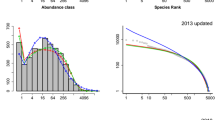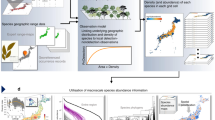Abstract
Average species-area curves were generated for vascular plants in 20 old-fields that were sampled in 1983, 1989, and 1994. These curves were fit with a saturating function to estimate total species richness for each old-field. Additional estimates of total species richness were generated by fitting the same saturating function to subsets of the species area curves and with a first-order jackknife procedure. Estimates of total species richness were strongly correlated with observed species richness. There was limited evidence suggesting that greater sampling was necessary to identify the same proportion of species in older, more species-rich old-fields.
Similar content being viewed by others
References
Arrhenius, O. 1921. Species and area. J. Ecol. 9: 95-99.
Baltanas, A. 1992. On the use of some methods for the estimation of species richness. Oikos 65: 484-492.
Dietvorst, P., van der Maarel, E., & van der Putten, H., 1982. A new approach to the minimal area of a plant community. Vegetatio 50: 77-91.
Gleason, H.A. 1922. On the relation between species and area. Ecology 3: 95-99.
Gleason, H.A. 1925. Species and area. Ecology 6: 66-74.
Goodall, D.W. 1952. Quantitative aspects of plant distribution. Biol. Rev. 27: 194-245.
Grigal, D.F., Chamberlain, L.M., Finney, H.R., Wroblewski, D.V. & Gross E.R., 1974. Soils of the Cedar Creek Natural History Area. Miscellaneous Report 123, University of Minnesota Agricultural Experiment Station, Saint Paul, Minnesota, USA.
Heltshe, J.F. & N.E. Forrester. 1983. Estimating species richness using the jackknife procedure. Biometrics 39: 1-11.
Hopkins, B. 1957. The concept of minimal area. J. Ecol. 45: 441- 449.
Inouye, R.S., Huntly, N.J., Tilman, D., Tester, J.R., Stillwell, M. and Zinnel, K.C., 1987. Old field succession on a Minnesota sand plain. Ecology 68: 12-26.
Palmer, M.W. 1990. The estimation of species richness by extrapolation. Ecology 71: 1195-1198.
Palmer, M.W. 1991. Estimating species richness: the second-order jackknife reconsidered. Ecology 72: 1512-1513.
Rosenzweig, M.L. 1995. Species Diversity in Space and Time. Cambridge University Press, Cambridge.
Tilman, D. & El Haddi, E. 1992. Drought and biodiversity in grasslands. Oecologia 89: 257-264.
Author information
Authors and Affiliations
Rights and permissions
About this article
Cite this article
Inouye, R.S. Species-area curves and estimates of total species richness in an old-field chronosequence. Plant Ecology 137, 31–40 (1998). https://doi.org/10.1023/A:1008052314255
Issue Date:
DOI: https://doi.org/10.1023/A:1008052314255




